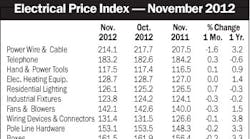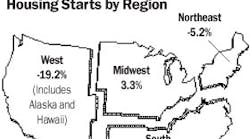Latest from Mag
People - Dec 21, 2012
Obituaries - Dec 21, 2012
November EPI Index Shows No Change
Housing Starts Dip 4% in November
Electrical Marketing - December 21, 2012
Around the Industry - Dec 21, 2012
DISC Corp., Orange, Conn., forecasts industry sales in 2005 at 6.8 percent over the 2004 level. For 2006, DISC expects industry growth to be better than 10 percent over the 2005 level.
DISC believes many dynamics are askew in the economy and the electrial industry, and doesn’t expect these dynamics to settle down much at least through the coming year. One of the big question marks is how the hurricanes will, in combination with the natural flow of economic events, impact the economy and the industry in terms of resources and dollars.
Estimates range from $100 billion to $200 billion for additional government spending resulting from the hurricanes. That’s quite a spread, and it means that no one currently has a solid answer on how much is needed. Whether it’s $100 billion, $200 billion or anything in between, remember that the actual number will also include big bucks for services, so it’s not all going for rebuilding or repairing the infrastructure in destroyed areas.
Other dynamics to consider include the overall economy’s continuing strength, the rising cost of energy, the rising prices of commodities important to distributors and rising interest rates. It’s a mixed bag, and we need to make some assumptions to get a reasonable expectation of what is ahead in the short run for our industry.
DISC Corp. doesn’t expect the impact of the hurricanes to untrack the overall economic expansion. It will slow growth in the last half of this year but should be offset by faster growth in 2006. DISC anticipates spending for rebuilding to be about $30 billion of about $100 billion of expenditures in total. This will be spread out over several years.
Rising prices have given cause for concern, and Federal Reserve Board Chairman Alan Greenspan has been ratcheting up short-term interest rates and will likely continue through the beginning of next year. Meanwhile, prices of some commodities important to the electrical industry have increased dramatically this year. DISC Corp. has built those expectations into its outlook for the remainder of 2005, through 2006, and beyond.
Clearly, rebuilding the infrastructure of New Orleans has nothing to do with the demand for electrical supplies and apparatus in the Atlanta market. Nevertheless, an exceptionally strong demand in one or more trading areas will have some impact on the national picture. The whole is equal to the sum of its parts.
The mechanics are straightforward. If nonresidential construction increases substantially in a few trading areas, it will certainly affect the national expenditures for nonresidential construction. As it happens, the single most important indicator in the DISC national forecast model is nonresidential construction.
DISC has built the expected local impact of the recent storms into the national forecast of nonresidential construction. In combination with other crucial indicators, DISC has also developed a forecast for the total electrical industry in general, and the major market segments in particular.
Nonresidential construction is comprised of a number of markets, among them commercial and health-care construction, factory construction and mining and exploration expenditures. The largest impact of the recent storms has been on the mining and exploration component, specifically oil rigs.
DISC anticipates a paltry 1.5 percent increase in nonresidential construction in 2005 over the 2004 level. Expect nonresidential construction growth in 2006 of 14 percent, according to our current forecast. This significant change is mainly a result of the recent storms.
In DISC’s July outlook (before Katrina/Rita) nonresidential construction spending in 2006 was expected to increase about 8.5 percent. Some of the difference between 14 percent and 8.5 percent is in a changing economic picture, absent the storms, but much is a result of the storms. In fact, the only component of nonresidential construction to show unusually large growth is in mining and exploration expenditures, up 39 percent. That is more than 25 percentage points higher than DISC provided in our July outlook.
Don’t view the huge increase in mining and exploration spending as an aberration. True, it’s still a forecast and not reality, but regardless of the actual increase, be assured the relationship between nonresidential construction spending and electrical distributor sales is and will be exceptionally strong.
The overall increase in nonresidential construction spending will first hit the distributor-served contractor market to the tune of more than 14.4 percent, compared with anticipated growth in 2005 of 5.6 percent. The distributor-served contractor market is the only segment that will show a double-digit gain next year. The three other important segments, industrial, utility and institutional will show an average gain of 7.8 percent in 2006 after growing 7.5 percent in 2005.
Contributing to the contractor market increase will be combined commercial/health-care and factory construction spending growth of 6 percent. If your business is concentrated in these sectors, look for continued expansion.
Here’s the bottom line. For the past three years the industry has had a well-deserved growth spurt in view of the three-year downturn experienced during 2001 through 2003. If DISC’s forecast is on target, the three-year cumulative growth for 2004 to 2006 will be about 23 percent.
I want to raise a red flag regarding 2007. It’s still a long way off, but the slowdown could be substantial. DISC sees cause for concern in the behavior of the key economic indicators driving the electrical industry, but every quarter we revisit our outlook and make adjustments for the following five-year cycle. We will keep you posted on our next short and long-range outlook in January. Stay tuned.

